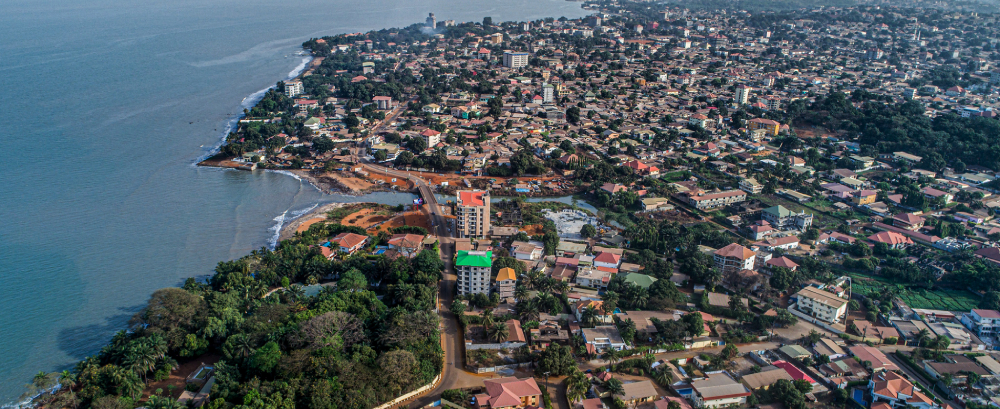
Gambia
April 12, 2025
Guinea-Bissau
April 13, 2025Guinea, located in West Africa, is one of the most resource-rich countries on the continent, particularly known for its vast reserves of bauxite. The mining sector plays a crucial role in the country’s economy, contributing significantly to its GDP and export revenues. Here’s an overview of the key mineral resources in Guinea:
Key Mineral Resources
Bauxite:
Overview: Guinea is the world’s largest producer of bauxite, which is the primary ore for aluminum. The country holds about a third of the world’s known bauxite reserves, making it a crucial player in the global aluminum industry.
Major Bauxite Mines: Some of the largest bauxite mining operations are located in the Boké region, where companies like Compagnie des Bauxites de Guinée (CBG) and Société Minière de Boké (SMB) operate. Other important areas include Kindia and Sangarédi.
Reserves: Guinea’s bauxite reserves are vast, ensuring the country’s leading position in global production for the foreseeable future.
Iron Ore:
Overview: Guinea has significant iron ore deposits, particularly in the Simandou mountains in the southeastern part of the country. The Simandou deposit is one of the largest untapped high-quality iron ore deposits in the world.
Reserves: The iron ore reserves in Guinea are extensive, with Simandou being the most notable, though there are other deposits as well. The development of these resources has been slow due to infrastructural and political challenges, but they hold significant potential.
Gold:
Overview: Gold is another important mineral resource in Guinea, with the country being one of the top gold producers in Africa. Gold mining is carried out by both large-scale industrial operations and small-scale artisanal miners.
Major Gold Mines: Significant gold mining operations are found in the Siguiri region, where AngloGold Ashanti operates the Siguiri Gold Mine, and in the Lefa region, where Nordgold operates the Lefa Gold Mine.
Reserves: Guinea’s gold reserves are substantial, and ongoing exploration activities continue to uncover new deposits, suggesting that production will remain strong.
Diamonds:
Overview: Guinea has diamond deposits, particularly in the regions of Banankoro and Macenta. While the diamond sector is not as developed as gold or bauxite, it remains an important part of the mining industry.
Reserves: Guinea’s diamond reserves are moderate, with both alluvial and kimberlite deposits. The potential for further exploration and development exists, particularly in artisanal mining areas.
Uranium:
Overview: Guinea has identified uranium deposits, particularly in the Fouta Djallon region. However, uranium mining is not yet fully developed in the country.
Reserves: The uranium reserves in Guinea are still being explored, and the extent of their economic viability remains to be fully assessed.
Nickel and Cobalt:
Overview: Guinea has deposits of nickel and cobalt, particularly in the southeastern part of the country. These minerals are important for various industrial applications, including battery production.
Reserves: The reserves of nickel and cobalt in Guinea are significant, but these resources are still underexplored compared to bauxite and iron ore.
Limestone:
Overview: Limestone is found in various parts of Guinea and is an essential raw material for the construction industry and cement production.
Reserves: The limestone reserves in Guinea are adequate to support local demand, particularly for the construction and infrastructure sectors.
Phosphates:
Overview: Guinea has phosphate deposits, which are used in agriculture and industrial processes.
Reserves: The phosphate reserves are moderate, and the sector has potential for development to support both domestic agriculture and export markets.
Zircon:
Overview: Zircon deposits, which are often found with titanium minerals, have been identified in Guinea. Zircon is used in various industrial applications.
Reserves: The zircon reserves in Guinea are still under exploration, with potential for further development.
Investment and Extraction Situation
- Bauxite Dominance: Bauxite mining dominates Guinea’s mineral sector, with the country being the world’s top producer. The industry has attracted significant foreign investment, particularly from companies in China and the United States. The government is focused on maximizing revenue from bauxite through better regulation and infrastructure development.
- Iron Ore Potential: The iron ore sector, especially the Simandou deposit, has long been seen as a potential game-changer for Guinea’s economy. However, political instability, infrastructure challenges, and legal disputes have delayed the full development of these resources.
- Gold Mining Expansion: Gold mining in Guinea has expanded rapidly, attracting both major multinational companies and artisanal miners. The government is working to formalize artisanal mining and improve the regulatory framework to ensure sustainable development.
- Environmental and Social Impact: The rapid expansion of mining activities in Guinea has led to environmental concerns, including deforestation, water pollution, and land degradation. Social issues, such as the displacement of communities and labor rights, also need to be managed carefully. The government is under pressure to ensure that mining activities are conducted sustainably and that the benefits are shared equitably with local communities.


